Most of us know that the Man of Steel’s first appearance was in the pages of 1938’s Action Comics #1…but what about his superhero origin story? We’ve heard the tale of how baby Kal-El, powered by the Earth’s yellow sun and raised by farmers named Jonathan and Martha Kent, would ultimately grow up to become Superman. However, did you know that hasn’t always been the case? For example, some comics depicted Clark growing up in an orphanage or in the city of Metropolis itself?
To make sense of all this, let’s dive into the Man of Steel’s archives and track the evolution of his origin. When was Krypton first named? When did we find out that Superman’s powers came from a yellow sun? When did he first become a farmer? Who the heck are Eben and Sarah? Let’s dive in.
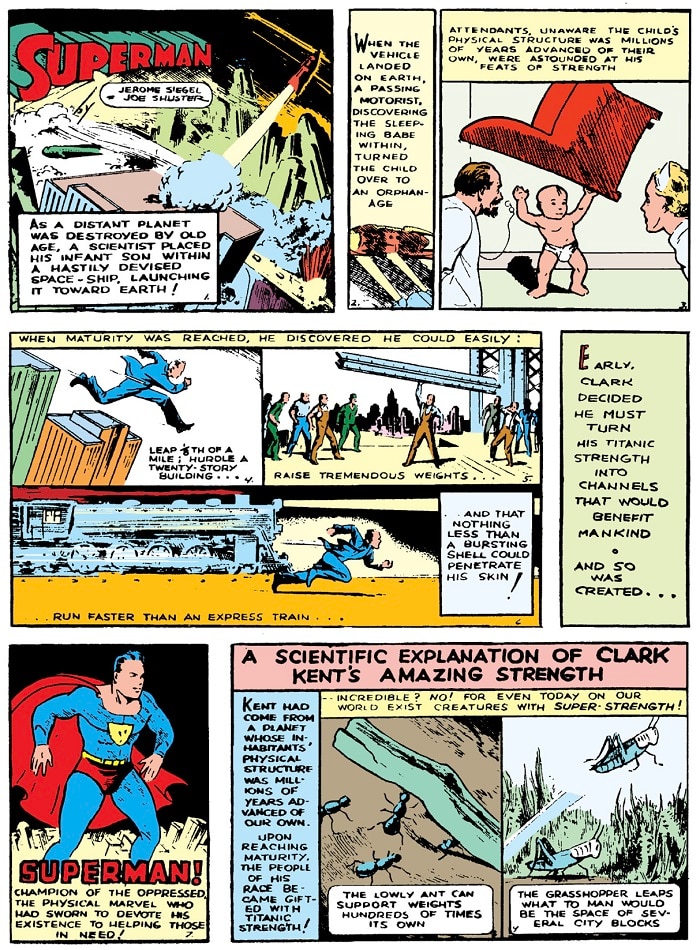
1938 - Action Comics #1
Superman’s first appearance devotes a single page to his origin. Jerry Siegel and Joe Shuster originally had an extended sequence detailing the Man of Steel’s origin, but it was ultimately cut for space. The details of Superman’s backstory are brief, establishing the bare basics. Readers see a panel of Krypton during its final moments, but the planet is unnamed. A caption tells us that the planet is dying of old age, so a scientist puts his son in a “hastily devised space-ship” which is then launched towards Earth.
The scientist is unnamed. The narration tells us that a “passing motorist” discovered the child and dropped him off at an orphanage. This moment isn’t seen, and the Kents are not named. We then see a panel of baby Clark Kent lifting furniture at the orphanage, much to the surprise of his minders, followed by a panel where an adult Clark is seen showing off his powers. This seems to imply that he grew up in the orphanage, which is a bit depressing.
The one-page origin story goes on to state that everyone from Clark’s unnamed home planet had the same super-strength he did. Siegel and Shuster show their work by saying that ants and grasshoppers can lift things larger than they are and jump great distances. If you were a kid in 1938, that explanation was all you needed. There is no mention of Earth’s yellow sun powering Clark.
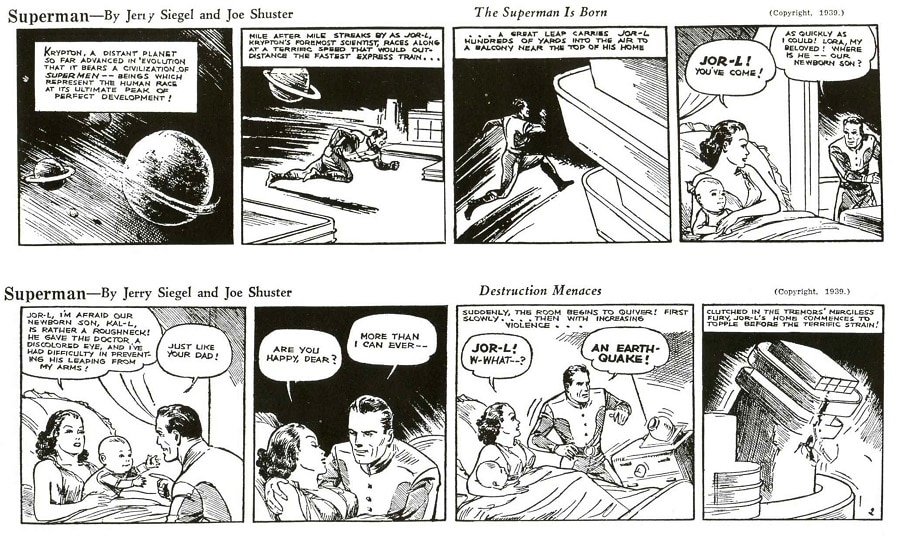
1939 - The Superman Newspaper Strip
In 1939, McClure Syndicate commissioned a Superman newspaper strip. This gave Siegel and Shuster a chance to expand on the origin and use some of the scenes they had to cut from Action Comics #1. There is an extended sequence on Krypton, which is named for the first time. Once again, we’re told that the planet is full of supermen. Jor-L and Lora are seen for the first time (note the original spelling), and we learn that Superman’s birth name is Kal-L.
Jor-L learns that Krypton is going to explode and tries to warn the Council, but the Council doesn’t believe him, forcing Jor-L to plan his own contingency. This exchange between Jor-L and the Council would become an essential part of the origin story in subsequent retellings. Earth is chosen as Kal-L’s destination because of its ability to support life.
The “passing motorist” mentioned in Action Comics #1 is seen rescuing the child from the rocket. This could technically be considered the first appearance of Jonathan Kent. However, the rest of the strip once again implies that Clark grew up in an orphanage.
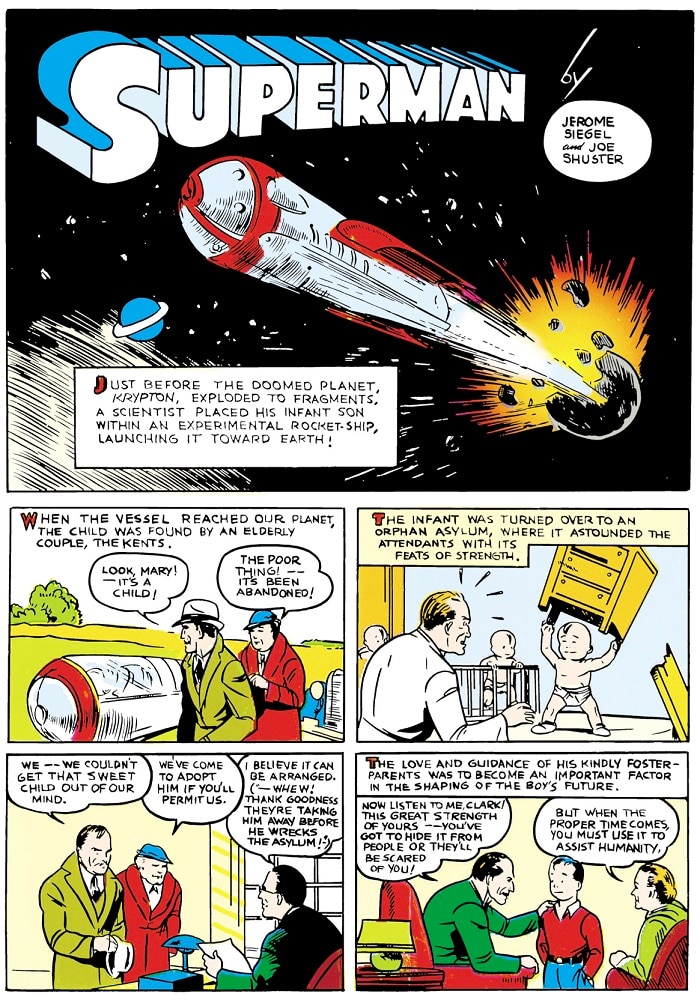
1939 - Superman #1
When Superman got his own title, his origin was expanded once again. Jor-L and Lora aren’t seen, but we get more panels focusing on Clark’s childhood. The “passing motorist” is given a wife, and we learn that their family name is Kent. The wife is identified as Mary, but the husband isn’t given a first name.
In a key difference, the Kents still turn the baby over to the orphanage, but quickly return to adopt him. This story establishes that Clark got his moral compass from his foster parents, a key theme that would carry over in subsequent retellings. However, the panels depicting Clark’s childhood show the young boy growing up in a metropolitan city, rather than a smalltown farm. When the Kents pass away, Clark makes the decision to become Superman.
1940 - The Adventures of Superman Radio Show
In 1940, the Man of Steel began starring in his own radio drama. The serial’s script took some interesting deviations from Superman’s previously established origin. For example, Krypton was in the same solar system as Earth, on the other side of the sun. When baby Kal-L’s rocket arrives on Earth, he emerges as a full-grown man, already in a Superman costume. He takes the name Clark Kent because a young boy suggests it to him.
Needless to say, these additions to the origin didn’t stick around.
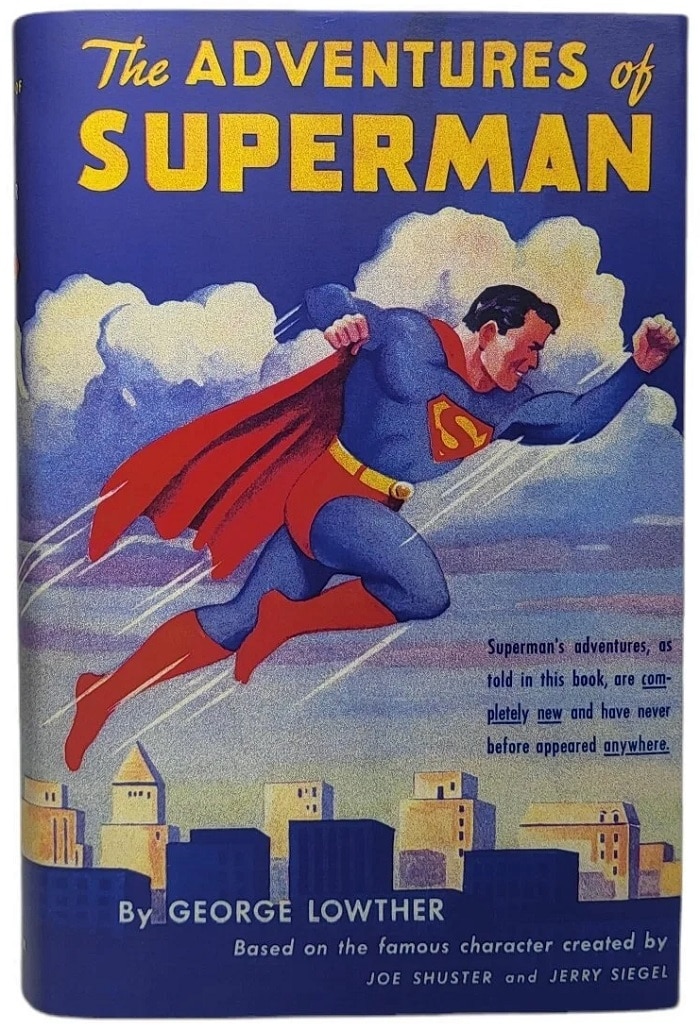
1942 - The Adventures of Superman by George Lowther
In 1942, George Lowther, one of the writers on the Adventures of Superman radio show authored a prose novel about Superman. Although the book has been mostly forgotten today, it made some very big lasting contributions to the origin story. The novel renames Lora to Lara and changes the spelling of Jor-el’s name. (Still, note that Jor-el is missing his traditional capitalization.)
Clark’s Earth parents here are named Eben and Sarah Kent. The novel also establishes that Clark was Sarah’s maiden name, a key piece of lore that would carry over in multiple retellings. The book presents the Kents as farmers for the first time, which would go on to become a defining aspect of Superman’s background.
In the novel, Clark’s powers slowly manifest as he grows up. This is in contrast to previous versions of his origin, where Clark had all of his abilities as a baby. This idea was abandoned in future retellings, but would later be adopted again for modern versions of the character.
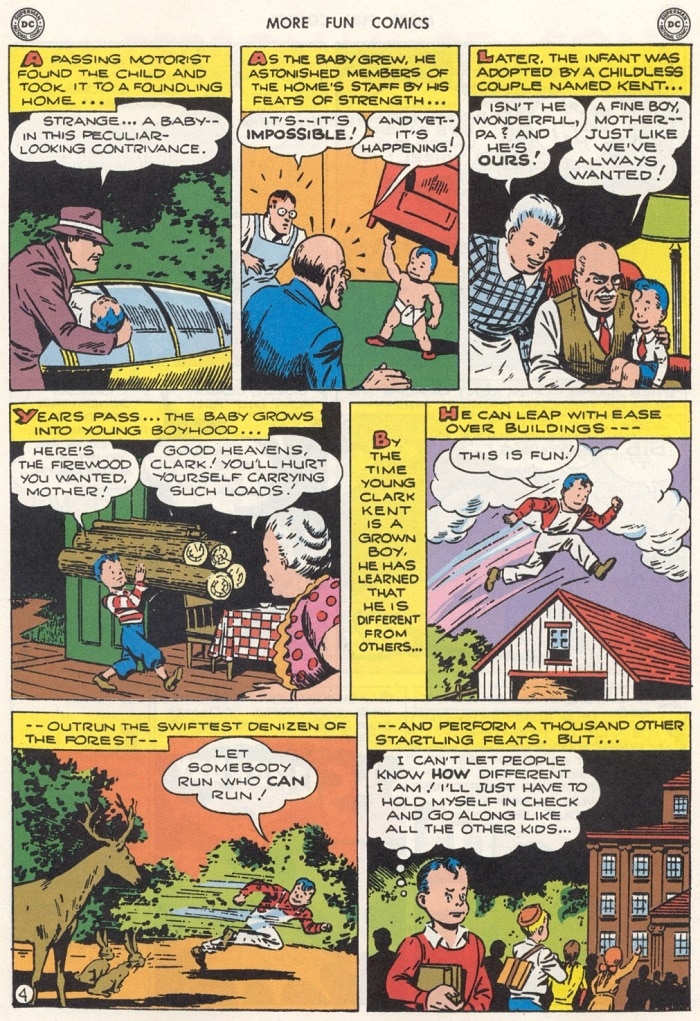
1944 - More Fun Comics #101
This issue of DC’s debut series introduced a retcon, establishing that Clark operated as Superboy during his youth. The origin story is retold again, and in the process, Jor-El and Lara are seen in a comic book for the first time (previous appearances were in radio, newspaper strips and the prose novel). In addition, Jor-El’s name is given its traditional capitalization for the very first time.
Previous depictions of Krypton presented the world as a race of supermen, but this comic was the first version of the origin to establish that Kryptonians were powerless on their homeworld. According to this version of the story, the Earth’s gravity gave Superboy his extraordinary powers. This change addressed why the Kryptonians didn’t use their superpowers to escape their planet’s destruction.
1948 - Superman Movie Serial
In 1948, Columbia Pictures produced a 15-part Superman film serial. This is the first version of the origin where Mrs. Kent sews Clark’s Superman costume, using material from the baby blankets found in his rocket.
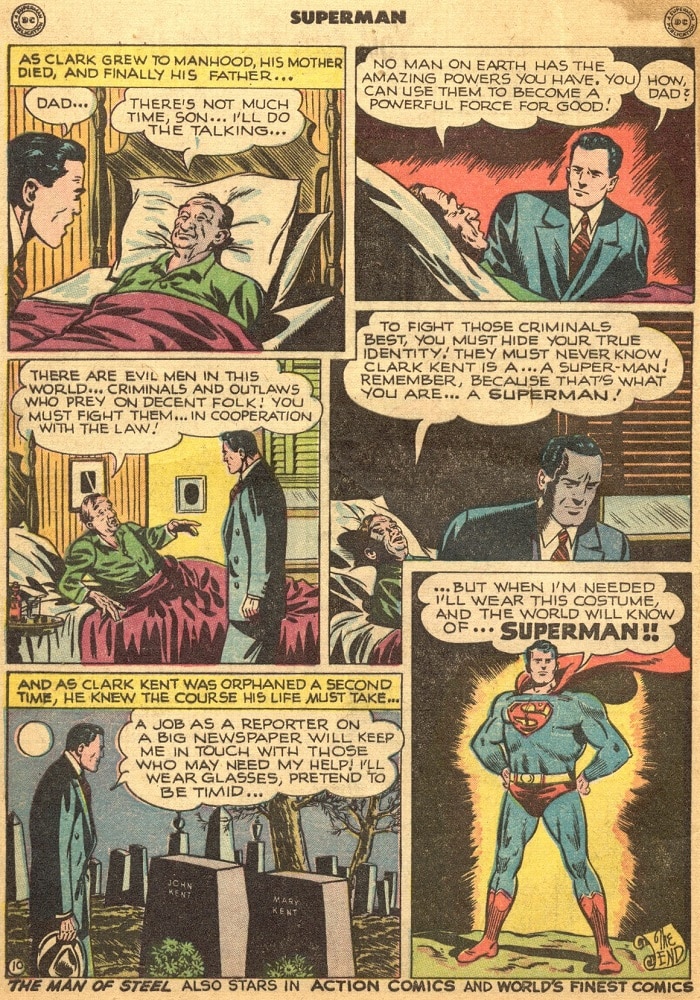
1948 - Superman #53
DC Comics celebrates Superman’s 10th anniversary by retelling his origin. Clark’s Earthbound parents are renamed John and Mary Kent.
1949 - Superboy #2
Smallville is named for the first time. Prior to this issue, the setting of Clark’s childhood years was inconsistent. In fact, some early Superboy stories erroneously stated that Clark grew up in Metropolis.
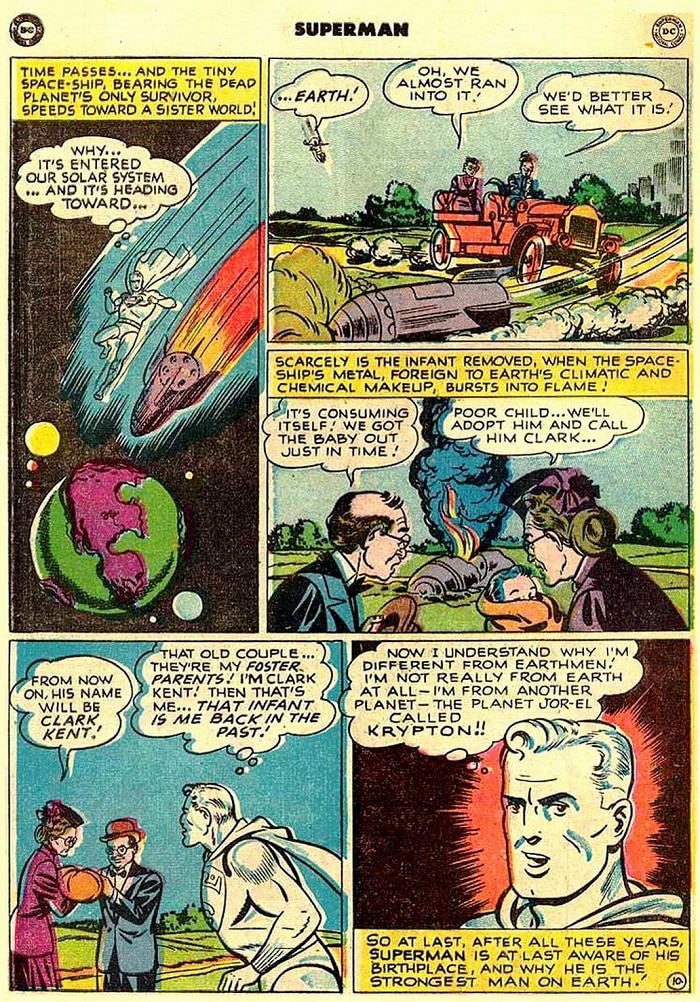
1949 - Superman #61
Superman learns about his Kryptonian origins firsthand as he travels back in time and observes Krypton’s final days. As a time-traveling phantom, Kal-El is unable to interact with the world around him, but he’s able to observe it. He learns his birthname, who his parents were and where he came from. Previously, these facts had been known to the readers but not to Superman himself.
1950 - Superboy #12
Mary Kent is renamed Marthe. Close, but not quite right yet.
1951 - Adventure Comics #169
WHY DID YOU SAY THAT NAME?! Marthe Kent is renamed Martha Kent.
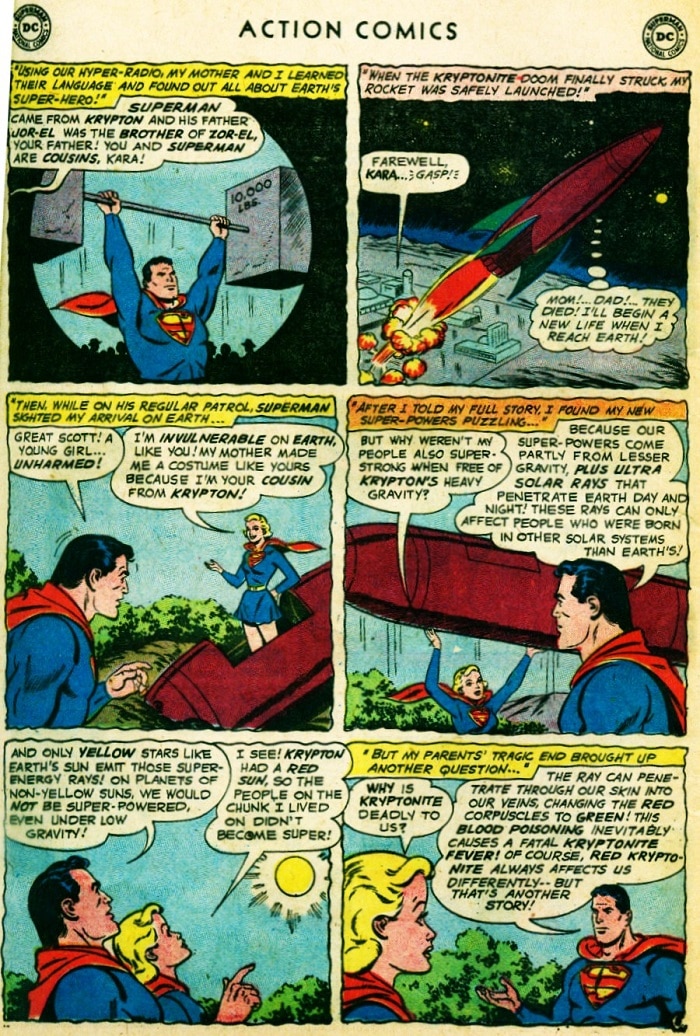
1960 - Action Comics #262
This issue introduced the idea that Superman gets his powers from Earth’s yellow sun while his home planet of Krypton orbits a red sun. This became the permanent explanation for Superman’s powerset going forward.
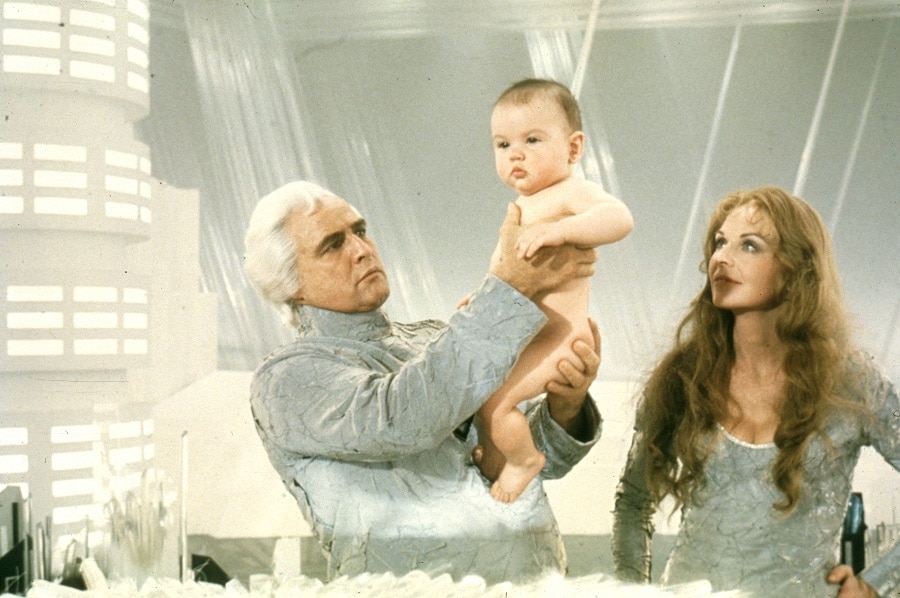
1978 - Superman: The Movie
In addition to being a groundbreaking superhero movie, 1978’s Superman also added some key elements to Superman’s origin. The movie establishes that the S on Superman’s chest is a family crest representing the House of El. The film also places Smallville in the state of Kansas for the first time.
Superman presents the Fortress of Solitude as a giant crystalized structure containing a living recording of the Man of Steel’s parents and all of Krypton’s history. In this version of the origin, Superman learns about his heritage from a living recording of his father Jor-El, which probably makes more sense than time travel. The relationship between Superman and his “ghost dad” would become a key part of the mythos.
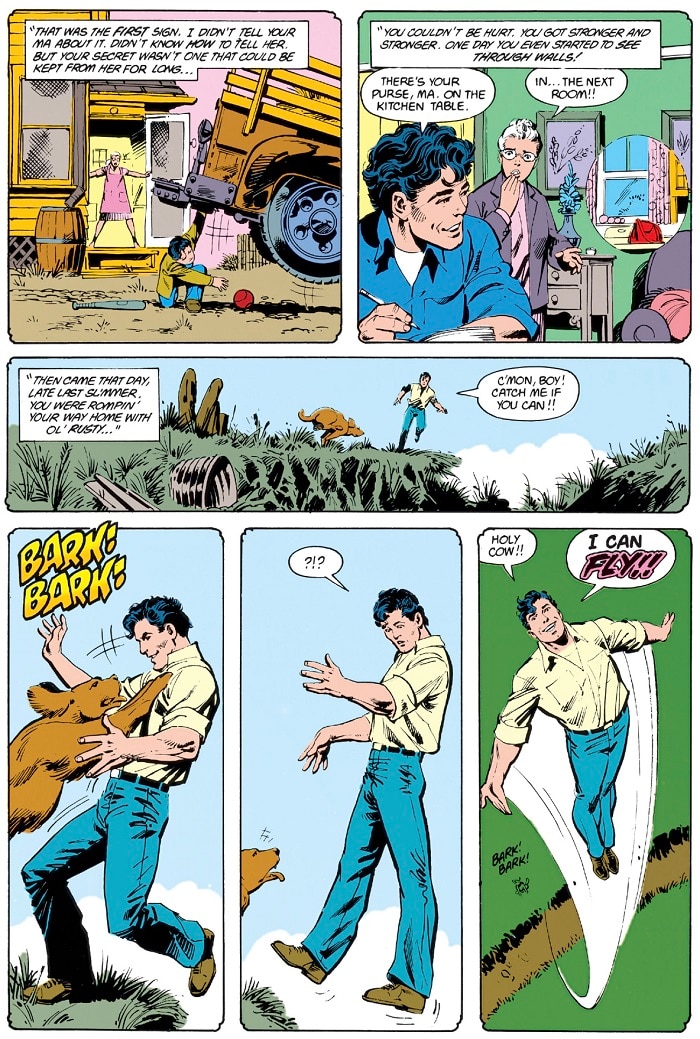
1986 - The Man of Steel
After the reality warping events of Crisis on Infinite Earths, comic book writer and artist John Byrne famously retold Superman’s origin in a groundbreaking limited series. This version of the origin combined elements from the Golden Age and the 1978 film, creating a new comprehensive version of Superman’s backstory. Clark’s history as Superboy was erased, and the Kents survived to see their son become Superman.
This time around, Clark didn’t develop his powers until his adolescence, erasing the idea that Clark was super-powered as a baby and bringing back the status quo established in the George Lowther novel. The origin presented in The Man of Steel would become the gold standard going forward, with most retellings building off its concepts and themes.
Superman’s origin keeps on reinventing itself, and we wouldn’t have it any other way. Still, it’s great to consider how much it’s evolved already. The next time you see the Kent farm on Superman & Lois, think of the George Lowther novel. When you watch the Martha scene in Batman v Superman: Dawn of Justice, think of Adventure Comics #169. Superman’s origin is a constantly changing story, building off everything that came before it. That’s one of the things that makes his legacy so special.
Joshua Lapin-Bertone writes about TV, movies and comics for DC.com, is a regular contributor to the Couch Club and writes our monthly Batman column, "Gotham Gazette." Follow him on X at @TBUJosh.















